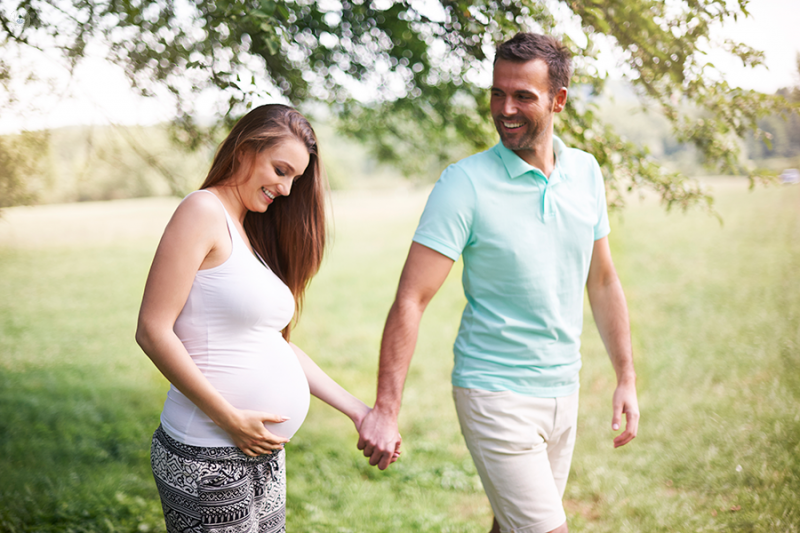

What is it?
Pregnancy is the physiological condition of a woman, starting from the moment of conception of the foetus and goes on with the baby’s growth, until birth. Pregnancy is usually categorised by weeks (for a total of 40) and lasts around 280 days. Under particular circumstances, the baby can be born before (premature birth) or after the estimated due date.

Conception
Conception is the result of the semen entering the woman’s reproductive system. The spermatozoa in the semen then travel through the cervix to the Fallopian tubes. The ovum or egg, which can be found in the Fallopian tubes, is then fertilised by a sperm and undergoes a series of cellular divisions while it travels to the uterus. If more than one egg is released, or if one fertilised egg splits into more than one embryo, this leads to a multiple pregnancy.
Once it has reached the uterine cavity, the fertilised egg adheres to and penetrates into the uterine lining (the endometrium). From that moment on, the foetus starts developing.
Women’s fertility reaches its peak during ovulation, when the egg moves towards the Fallopian tubes. This time frame can last up to six days and it is known as ‘fertile window’.
40 weeks of gestation
Gestation usually lasts 40 weeks, which is the time it takes for the baby to develop. The first eight weeks are really important because at that time the baby is developing the organs he or she needs to survive. The mother will have symptoms such as nausea, irritability, fatigue and enlarged breasts.
Between weeks eight to 13, the mother’s body will start changing; the baby’s genital organs will differentiate and the vocal cords will be formed. At that time, the most critical part of the pregnancy is over, leaving behind most risks of abortion or health problems for the baby. So, the second trimester of pregnancy begins.
From week 13 to 17, the mother will feel less tired and the nausea will go away; the baby is now fully formed.
From week 17 to 21, the mother will start feeling the first movements of the baby.
Between weeks 21 to 26 the mother’s belly will become more evident and she will start feeling the first uterine contractions; at the same time, the baby’s weight will increase, the eyelids will start opening and closing and he or she will start trying to breathe.
Week 26 is the beginning of the last trimester. The baby will keep on growing and between weeks 30 to 35 he or she will change position in order to get ready for birth; the mother will start suffering from intense back and abdominal pain and the uterine contractions will become more frequent.
During the last month of gestation (weeks 35 to 40), the baby will be fully developed and will start turning upside down, with the head towards the pelvic cavity.
Throughout a pregnancy there are certain nutritional guidelines recommended to promote healthy development and to ensure the woman is consuming enough calories. Women are also advised to abstain from alcohol and smoking because of the risks these pose to their baby.
What tests are carried out during pregnancy?
During pregnancy, you have several tests, depending on your pregnancy and how it is going, as part of your antenatal care. Certain tests are standard and given to all patients, whilst others are given only in certain scenarios, such as cases of a high-risk pregnancy. The following tests may be carried out by an obstetrician who has specialised further in fetal medicine.
What complications are there related to pregnancy?
Unfortunately, not all pregnancies are the same, with some women experiencing certain complications. These can include:
Labour
Labour, or childbirth, is when the baby leaves the mother’s body. It can happen in several ways:
Natural: also known as vaginal birth or spontaneous birth;
Caesarean section or C-section: carried out if baby is in the breech position (feet first), if the mother has a low-lying placenta (placenta praevia), if the baby is in distress, if it’s a twin pregnancy, if the mother has had uterus surgery before or if either the mother’s or the baby’s health is in danger. A C-section can be planned, or it can be chosen as an emergency measure;
Induced birth: if it is two weeks past the due date and the baby is not out yet, and either the mother’s or the baby’s health is in danger, delivery can be induced manually or by administering oxytocin and giving an epidural to the mother.
Many women will choose to prepare for childbirth, by doing their research, getting advice or attending childbirth classes. Some women may even choose to do exercises designed to help strengthen their pelvic floor, such as pregnancy pilates. Other women may also see an osteopath to help with symptoms such as lower back pain. Women may also seek postpartum osteopathy for helping them after birth in certain areas.
Which doctor should I talk to?
Pregnancy is a very delicate period both for the future mother and for the baby: that is why they both need to be assisted throughout this whole journey. It is important to see a specialised obstetrician/gynaecologist, who will be able to give you more information about pregnancy, what are the related risks and symptoms and what to do so that both you and your baby will be perfectly healthy.
